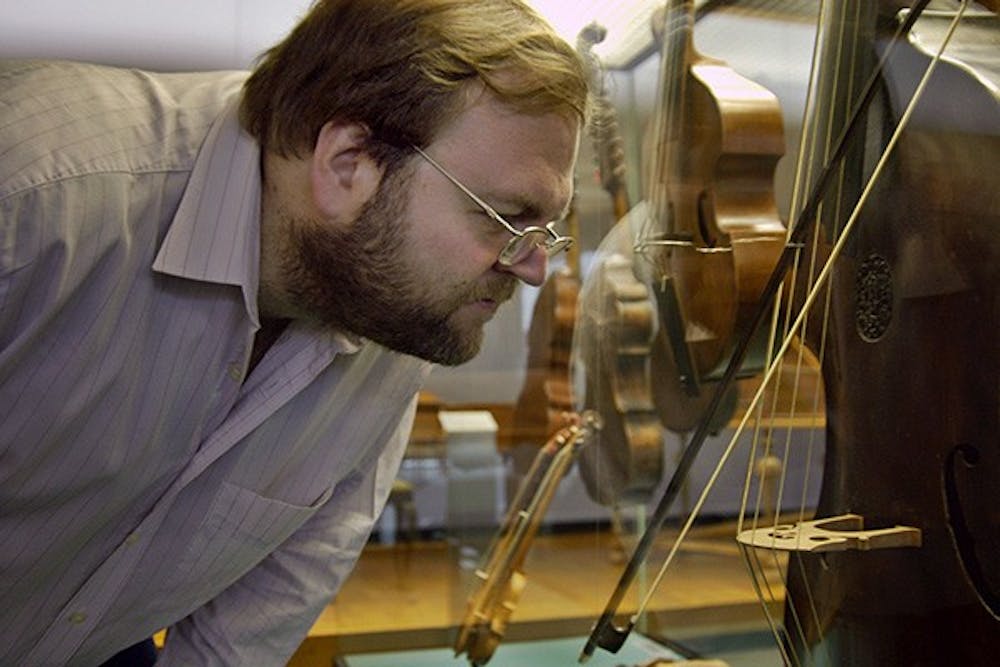 Volker Schier, a musicologist and visiting scholar at ASU, was co-director of the Opening the Geese Book project alongside Corine Schleif. (Photo Courtesy of Volker Schier)
Volker Schier, a musicologist and visiting scholar at ASU, was co-director of the Opening the Geese Book project alongside Corine Schleif. (Photo Courtesy of Volker Schier)Two ASU professors helped make a 500-year-old German hymn book available to the world by incorporating audio and video with pictures of the 1,120-page handwritten manuscript.
Along with international partners, ASU art historian Corine Schleif and musicologist Volker Schier directed the transition of the Geese Book, which was originally available only to a handful of scholars, into a contextualized digital presence.
For more than a decade, their team converted the two-volume manuscript filled with chants and detailed illustrations into what they call "Opening the Geese Book," an organized collection of multimedia elements containing thousands of high-resolution photos, explanations of the illustrations and recordings of the chants.
The manuscript was originally produced in Nuremberg, Germany, between 1503 and 1510 and was used at the church of St. Lorenz until 1525. It was later given to the U.S. and received a new home at the Morgan Library & Museum in New York; the book remains there today.
Schleif and Schier’s project has received a lot of positive feedback.
“We have many thousands of hits from basically every country in the world, from Russia, Japan, Australia, some parts of Africa, all European countries, North and South America,” Schier said. “People sometimes take components that they like. Some people just listen to the music and some scholars even compare the Geese Book to the material they are working with.”
The project first started with a debate. After Schleif completed her dissertation, which discussed donations of all kinds from St. Lorenz including the Geese Book, Schier challenged her position on the manuscript's importance.
 Corine Schleif, an art historian at ASU, was co-director of the Opening the Geese Book project alongside Volker Schief. (Photo Courtesy of Volker Schier)
Corine Schleif, an art historian at ASU, was co-director of the Opening the Geese Book project alongside Volker Schief. (Photo Courtesy of Volker Schier)Schleif said because the manuscript was made after printed books, it was used to represent the church as a big monument, a work of art.
“Then this musicologist, whom I didn’t know, read this and he wanted to disagree with me in print,” Schleif said. “So while he was writing his article about the Geese Book saying how it was important musically, and how I was wrong when I thought it was important art historically, we actually met by accident at a conference, and we started working together on the idea for this project.”
Because the project had aspects that both Schleif and Schier could appreciate, it didn’t always seem like work.
“Well, as an art historian I was really interested in these enigmatic pictures at the bottoms of the pages because they have nothing to do with anything religious,” Schleif said. “I wanted to figure out what those were all about, so my area of expertise was not only as an art historian but as a historian. I worked a lot with the history of Nuremburg."
Schleif said she always likes to ask why.
"Not just how is something made, what about the style and dating, but to go beyond that and look at why it was done the way it was done and when, and sort of the politics of the sociology and the people behind the works," she said.
The two said their goal was to make the manuscript available to the world while contextualizing it to a modern era while using multimedia tools.
“We think it’s very interesting to place the book into a context, historical context to show people how a large parish church in the Middle Ages worked,” Schier said. “You had a whole gremium (community) of people working on it like fundraising, authorizing it, collecting the material, writing it, illuminating it. And, as we tried to show, these were often different people.”
Schier said the manuscript itself is a multimedia item that contains lavish illustrations, hymns and text. The digital transition of the manuscript felt only natural and inevitable.
In a way, decades after World War II, Schleif and Schier have given the people of Nuremberg their book back.
The two also taught a seminar on the Geese Book. ASU alumna Jessica Roode was one of their students and served as a curatorial assistant for them.
 The choir of geese illustration, for which the manuscript is named after, has been the subject of numerous scholarly interpretations. (Photo Courtesy of Volker Schier)
The choir of geese illustration, for which the manuscript is named after, has been the subject of numerous scholarly interpretations. (Photo Courtesy of Volker Schier)“Over the course of my seminar class and internship, the research and transcription I had completed had re-introduced me to the idea that complex relationships could exist between the written text of a manuscript and its images," Roode said in an email. “For me, the knowledge that an image or a figure within a scene had a physical context from which it was being drawn was not absent in my consideration of an object, but it had been sidelined to a degree."
Schleif and Schier said they hope people from all over the world enjoy reading the manuscript and learning more about its origins, but they also hope that their audience takes away a few lessons from the project.
Schleif said she thinks It’s interesting to look at the animal allegories and to see how it was possible within a sacred setting to integrate social criticism such as criticism of authority and warnings.
“That is something very admirable, and I think it is something we should never stop being vigilant or critical about what’s going on and if they were able to embed that in these pictures, appearing so charming and whimsical, we shouldn’t lose faith today. We should also continue to be critical all the time; we shouldn’t be frightened.”
Schier added to Schleif's comments by saying the audience should both enjoy it and learn from it.
“I think people should of course enjoy it, but they should also see that history, art and historic music don’t have to be boring," Schier said. "It can be very interesting to look into and even more so if it’s put into a context where you have all of these multimedia components coming together."
Reach the reporter at anicla@asu.edu or follow him on Twitter @andrewniclaASU
Like The State Press on Facebook and follow @statepress on Twitter.




